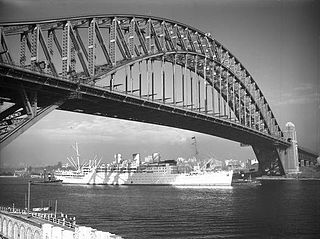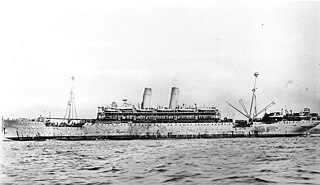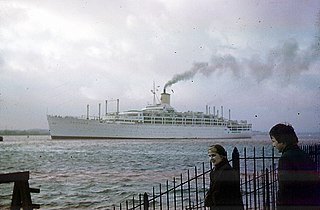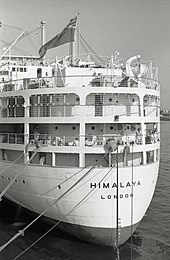
Queen Elizabeth was an ocean liner operated by Cunard Line. In tandem with Queen Mary both ships provided a weekly luxury liner service between Southampton in the United Kingdom and New York City in the United States, via Cherbourg in France.

SS Canberra was an ocean liner, which later operated on cruises, in the P&O fleet from 1961 to 1997. She was built at the Harland and Wolff shipyard in Belfast, Northern Ireland at a cost of £17 million. The ship was named on 17 March 1958, after the federal capital of Australia, Canberra. She was launched on 16 March 1960, sponsored by Dame Pattie Menzies, wife of the then Prime Minister of Australia, Robert Menzies. She entered service in May 1961, and made her maiden voyage starting in June. In the 1982 Falklands War she served as a troopship. In 1997 the singer and songwriter Gerard Kenny released the single "Farewell Canberra" which was specially composed for the last voyage.

SS Arcadia was a passenger liner built for P&O in 1953 to service the UK to Australia route. Towards the end of her life she operated as a cruise ship, based in Sydney, until scrapped in 1979.

The Orient Steam Navigation Company, also known as the Orient Line, was a British shipping company with roots going back to the late 18th century. From the early 20th century onwards, an association began with P&O which became 51% shareholder in 1919 and culminated in the Orient Line being totally absorbed into that company in 1966.

The SS Mongolia was a steam turbine-driven twin-screw passenger-and-cargo ocean liner launched in 1922 for the Peninsular and Oriental Steam Navigation Company (P&O) for service from the United Kingdom to Australia. Later in P&O service she sailed for New Zealand, and in 1938 she was chartered to a P&O subsidiary, the New Zealand Shipping Company, as SS Rimutaka.

RMS Empress of Australia was an ocean liner built in 1913–1919 by Vulcan AG shipyard in Stettin, Germany for the Hamburg America Line. She was refitted for Canadian Pacific Steamships; and the ship – the third of three CP vessels to be named Empress of China – was renamed yet again in 1922 as Empress of Australia.

RMS Arundel Castle was a British ocean liner and Royal Mail Ship which entered service in 1921 for the Union-Castle Line. A previous vessel of the same name was built in 1864 by Donald Currie & Co. and sold in 1883, whereupon it was renamed Chittagong. Originally laid down as the Amroth Castle in 1915, building was delayed by the First World War. She was eventually launched on 11 September 1919. She was completed on 8 April 1921 and in 22 April 1921 the ship departed from Southampton on her maiden voyage to Cape Town. During World War 2 she was requisitioned by the Admiralty to serve as a troopship. After the war she resumed passenger service, eventually being scrapped in 1959.

USS General O. H. Ernst (AP-133) was a General G. O. Squier-class transport ship for the U.S. Navy in World War II. She was named in honor of U.S. Army general Oswald Herbert Ernst. She was decommissioned in 1946 and transferred to the Army Transport Service as USAT General O. H. Ernst. She was sold privately in 1964 and renamed SS Calmar, and was scrapped in 1980.

RMS Strathaird, later TSS Strathaird, was an ocean liner of the Peninsular and Oriental Steam Navigation Company (P&O).

The SSLurline was the third Matson Lines vessel to hold that name and the last of four fast and luxurious ocean liners that Matson built for the Hawaii and Australasia runs from the West Coast of the United States. Lurline's sister ships were SS Malolo, SS Mariposa and SS Monterey. Lurline served as a troopship in World War II operated by War Shipping Administration agents serving Army troop transport requirements. Bought by the Chandris Lines in 1963 as the RHMS Ellinis the ship became one of the most important luxury cruise ships on the Australian and New Zealand services. She operated in Australasia and Oceania until 1980.

USS Aeolus (ID-3005), sometimes also spelled Æolus, was a United States Navy transport ship during World War I. She was formerly the North German Lloyd liner SS Grosser Kurfürst, also spelled Großer Kurfürst, launched in 1899 that sailed regularly between Bremen and New York. At the outset of World War I the ship was interned by the United States and, when the U.S. entered the conflict in 1917, was seized and converted to a troop transport.

SS Friedrich der Grosse was a Norddeutscher Lloyd liner built in 1896 which sailed Atlantic routes from Germany and sometimes Italy to the United States and on the post run to Australia. At the outset of World War I the ship was interned by the U.S. and, when that country entered the conflict in 1917, was seized and converted to a troop transport, becoming USS Huron (ID-1408).

Asama Maru was a Japanese ocean liner owned by Nippon Yusen Kaisha (NYK). The ship was built in 1927–1929 by Mitsubishi Shipbuilding & Engineering Co. at Nagasaki, Japan. The vessel was named after an important Shinto shrine.

USS Princess Matoika (ID-2290) was a transport ship for the United States Navy during World War I. Before the war, she was a Barbarossa-class ocean liner that sailed as SS Kiautschou for the Hamburg America Line and as SS Princess Alice for North German Lloyd. After the war she served as the United States Army transport ship USAT Princess Matoika. In post-war civilian service she was SS Princess Matoika until 1922, SS President Arthur until 1927, and SS City of Honolulu until she was scrapped in 1933.

RMS Orion was an ocean liner launched by the Orient Steam Navigation Company in 1934 and retired from the water in 1963 after carrying about 500,000 passengers. A 23,371 ton passenger ship, the Orion was built to carry 486 first class, 653 tourist class passengers and 466 crew from Europe through the Pacific to Australia. The construction of the ship was documented in Paul Rotha's 1935 film Shipyard.

SS Orsova, was a British ocean liner, built by Vickers Armstrong in Barrow-in-Furness, England, for the Orient Steam Navigation Company for their Great Britain-to-Australia services via the Suez Canal. She was the final development of the 28,000 ton class which began with the SS Orcades of 1948 and continued with the SS Oronsay of 1951. In 1960, in conjunction with the introduction of the new larger and faster Oriana and Canberra, the fleets of Orient and P&O were combined as P&O-Orient Lines, although the Orient ships retained their corn-coloured hulls and sailed under their own house flag. In 1966, P&O acquired the balance of the Orient shares and the Orient Line was discontinued, with Orsova and her fleet mates being transferred to the ownership of the Peninsular & Oriental Steam Navigation Company (P&O), painted white and under the P&O houseflag.

SS Orcades was an ocean liner serving primarily the UK – Australia – New Zealand route. She started service as a British Royal Mail Ship (RMS) carrying first and tourist class passengers. Orcades carried many migrants to Australia and New Zealand and was later used as a cruise ship, and is featured in the British Pathe films "I am a passenger" on YouTube. She also made several voyages from Canada (Vancouver). "Orcades" is the Latin name for the Orkney Islands.

Carinthia was an ocean liner built in 1956 as one of the four Saxonia class ships. She sailed for Cunard Line from her completion until 1968 when she was sold to Sitmar Line, rebuilt into a full-time cruise ship and renamed SS Fairsea. She sailed with Sitmar until 1988, when Sitmar was sold to P&O. She was renamed SS Fair Princess and sailed for Princess Cruises and P&O Cruises until 2000. She was then sold to China Sea Cruises and renamed SS China Sea Discovery. In 2005 or 2006 she was scrapped in Alang, India.

The SS Chusan was a British ocean liner and cruise ship, built for the Peninsular and Oriental Steam Navigation Company's Indian and Far East Service in 1950. She was named after Chusan, a small island off China. A smaller version of the SS Himalaya, the Chusan had a gross register tonnage of 24,215; and a capacity of 1,565 passengers and crew. She was built as a replacement for the RMS Viceroy of India, lost in the Second World War. She was 646.5 feet (197.1 m) long. The Chusan is said to have brought new standards of shipboard luxury to India and the Far East. She was the last passenger liner built for P & O by Vickers-Armstrongs.

Lavia was a cruise ship that caught fire and sank in Hong Kong Harbour in 1989. She was built for Cunard White Star Line in 1947 as the cargo liner Media. In 1961 she was sold to Italy, rebuilt as an ocean liner and renamed Flavia. In 1969, she was refitted as a cruise ship and renamed Flavian. In 1982 she was sold to Panama and renamed Lavia. She was undergoing a refit when the fire occurred. The damage to her was so great that she was scrapped.























